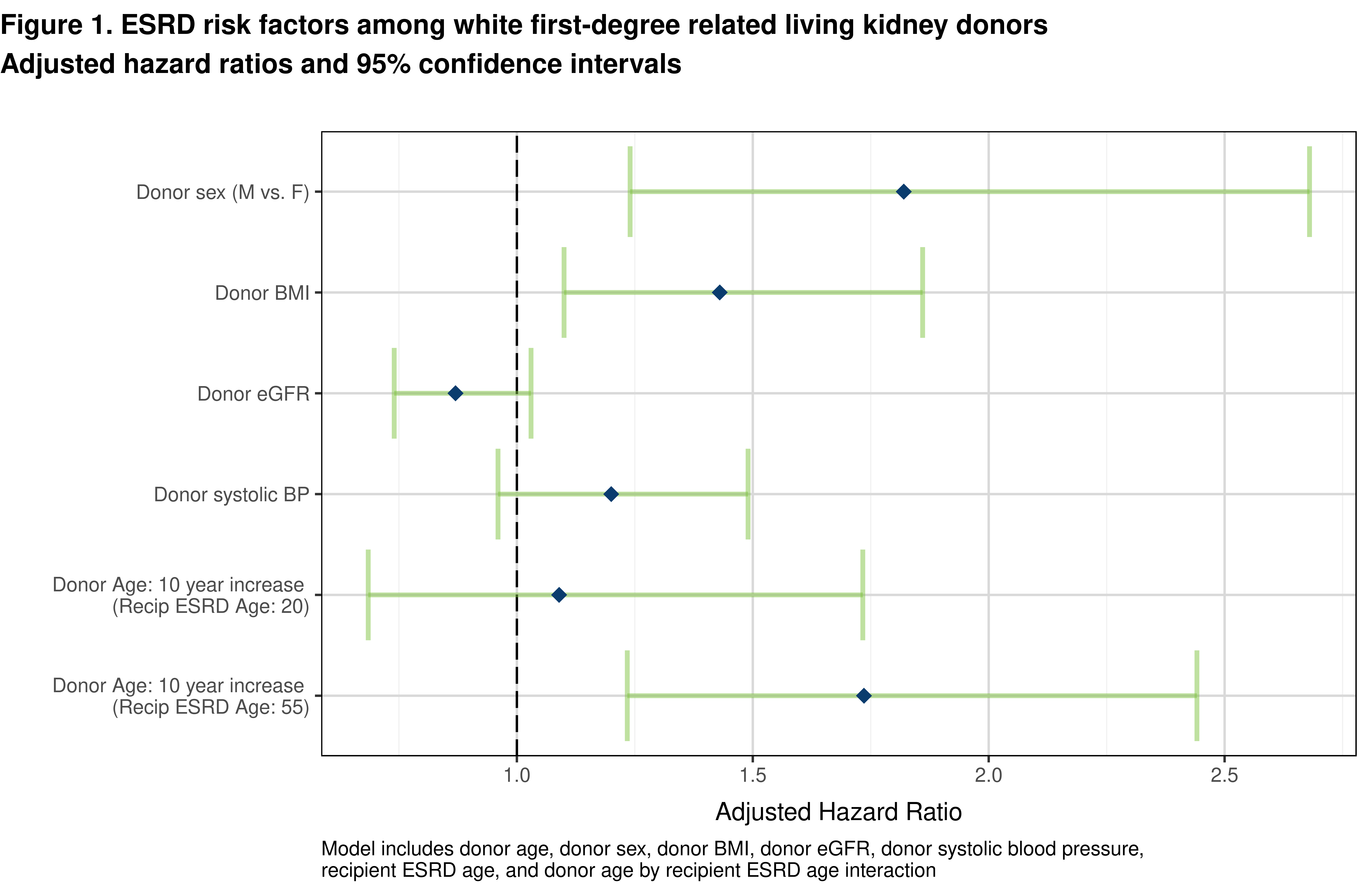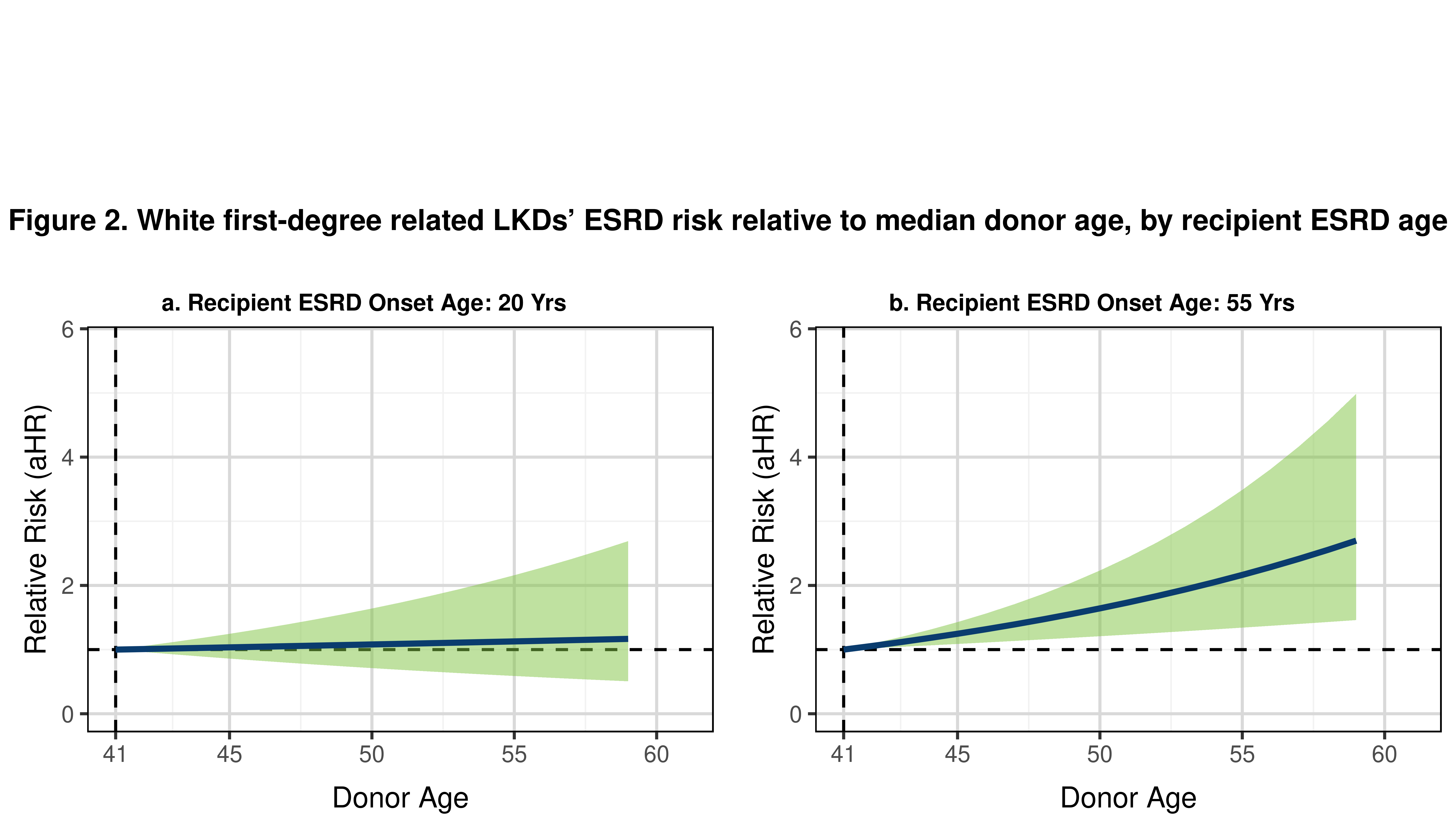Recipient and Donor Factors Associated with Post-Donation ESRD in Related White Living Kidney Donors
1Research, UNOS, Richmond, VA, 2Chief Medical Officer, UNOS, Richmond, VA
Meeting: 2020 American Transplant Congress
Abstract number: 356
Session Information
Session Name: Kidney Living Donor: Long Term Outcomes
Session Type: Oral Abstract Session
Date: Saturday, May 30, 2020
Session Time: 3:15pm-4:45pm
 Presentation Time: 3:27pm-3:39pm
Presentation Time: 3:27pm-3:39pm
Location: Virtual
*Purpose: We studied post-donation ESRD in white first-degree related living kidney donors (RLKDs) in the US between 1994 and 2018 (n=45700); this study is the first of its kind to adjust for recipient factors.
*Methods: We ascertained ESRD with OPTN and CMS data and found 115 white first-degree RLKDs developed ESRD through December 2018 (Table 1). There were too few cases in other ethnic groups for these analyses.
*Results: We ran a multivariable Cox proportional hazards regression model and found white RLKDs had increased risk of ESRD if they were male or had higher BMI or higher systolic blood pressure (Figure 1); these findings align with previous studies. However, we also found the first evidence of a recipient factor predicting donor ESRD: an interaction between donor age at donation (yrs older than median donor age) and the related recipient’s age at first onset of ESRD. Among white RLKDs, older donor age was associated with higher risk if the related recipient first developed ESRD at an older age (e.g., at age 55, aHR:1.73, 95% CI:1.23-2.44, p=0.002; Figure 2b), but older donor age was not associated with higher risk if the related recipient developed ESRD at a younger age (e.g., at age 20, aHR:1.09, 95% CI: 0.68-1.73, p=0.71; Figure 2a).
*Conclusions: These findings further inform potential donor risk assessment and illustrate the importance of including relevant family factors in the evaluation and consent of potential RLKDs.
| Characteristic | ESRD (N = 115) | No ESRD (N = 45585) |
| Time observed (years), median(IQR) | 13.7 (10.2-18.2) | 14.0 (8.2-18.8) |
| Donor age (years) | 44.0 (34.0-51.0) | 41.0 (33.0-49.0) |
| Donor sex (male) | 69 (60%) | 19327 (42.4%) |
| Donor BMI (kg/m2) | 29.0 (25.7-31.6) | 26.5 (23.6-29.6) |
| Donor eGFR (mL/min) | 87.8 (73.2-102.3) | 95.1 (82.4-107.0) |
| Donor systolic BP | 130.0 (119.5-136.5) | 120.0 (112.0-130.0) |
| Full sibling of recipient | 59 (51.3%) | 22530 (49.4%) |
| Child of recipient | 18 (15.7%) | 12735 (27.9%) |
| Parent of recipient | 38 (33%) | 10320 (22.6%) |
| Recipient age at onset of ESRD | 37.6 (24.1-51.7) | 42.7 (27.6-55.8) |
To cite this abstract in AMA style:
Wainright J, Robinson A, Wilk A, Klassen D, Cherikh W, Cartwright L, Stewart D. Recipient and Donor Factors Associated with Post-Donation ESRD in Related White Living Kidney Donors [abstract]. Am J Transplant. 2020; 20 (suppl 3). https://atcmeetingabstracts.com/abstract/recipient-and-donor-factors-associated-with-post-donation-esrd-in-related-white-living-kidney-donors/. Accessed December 24, 2025.« Back to 2020 American Transplant Congress


